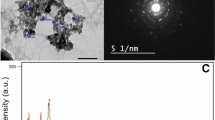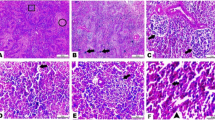Abstract
This study aimed to elucidate the response of broiler chickens to the dietary nano-zinc supplementation in terms of immune response and antioxidant activity. Ninety-one-day-old chicks (Ross 308) were randomly assigned to one of three dietary treatments in three replicates, in a feeding trial that lasted for 5 weeks. Birds were fed a basal diet supplemented with inorganic zinc oxide at 40 mg/kg diet (control), zinc oxide nanoparticles (ZnONPs) at 40 mg/kg diet (ZN1), or ZnONPs at 80 mg/kg diet (ZN2). Birds were injected with DNP-KLH at the 7th and 21st days from the beginning of the experiment, and blood samples were collected on days 7, 14, 21, 28, and 35 to determine the levels of immunoglobulin Y (IgY) and malondialdehyde as well as the antioxidant enzyme activities. Cellular immunity was assayed by estimation of phagocytic percentage and index of peripheral monocytes of blood and estimation of the T lymphocyte activity using a lymphocyte transformation test. The results showed that feeding broiler chickens a diet supplemented with ZnONPs increased (p < 0.05) the activity of superoxide dismutase and catalase and decreased the concentration of malondialdehyde compared to the control diet, without significant differences between NZ1 and NZ2 diets. Moreover, the chicks fed diets supplemented with ZnONPs showed a significant increase (p < 0.05) in serum IgY, total lymphocyte count, and macrophages compared to the control. A higher significant response for antibodies IgY concentration was observed in birds fed the NZ2 vs NZ1 diet. Also, there was a significant increase in phagocytic activity and phagocytic index in ZnONP-fed groups with a higher significance in the group fed NZ1 than with NZ2 diet as compared with the control. In conclusion, ZnONP application up to 80 mg/kg in the diet is safe for broiler chickens and could improve their antioxidant defense and cellular immunity.



Similar content being viewed by others

References
Aebi H (1984) Catalase in vitro. In: Packer L (ed) Methods in enzymology, vol 105. Academic Press Inc.: San Diego, pp 121–126
Abedini M, Shariatmadari F, Torshizi MAK, Ahmadi H (2018) Effects of zinc oxide nanoparticles on performance, egg quality, tissue zinc content, bone parameters, and antioxidative status in laying hens. Biol Trace Elem Res 184:259–267. https://doi.org/10.1007/s12011-017-1180-2
Ahmadi F, Ebrahimnezhad Y, Ghalehkandi J et al (2014) The effect of dietary zinc oxide nanoparticles on the antioxidant state and serum enzymes activity in broiler chickens during starter. International Conference on Biological, Civil and Environmental Engineering (BCEE-2014) March 17-18, 2014 Dubai (UAE)
Ali S, Masood S, Zaneb H et al (2017) Supplementation of zinc oxide nanoparticles has beneficial effects on intestinal morphology in broiler chicken. Pak Vet J 37(3):335–339
Azza H, Hegazi SM, Bakr AA et al (2017) Effect of zinc oxide nanoparticles on growth performance and absorptive capacity of the intestinal villi in broiler chickens. Life Sci J 14(11):125–129. https://doi.org/10.7537/marslsj141117.18
Bach JF, Dardenne M (1989) Thymulin, a zinc-dependent hormone. Med Oncol Tumor Pharmacother 6:25–29
Burrell AL, Dozier WA, Davis AJ et al (2004) Responses of broilers to dietary zinc concentrations and sources in relation to environmental implications. Br Poult Sci 45:255–263
Cohen G, Dembiec D, Marcus J (1970) Measurement of catalase activity in tissue extracts. Anal Biochem 34:30–38. https://doi.org/10.1016/0003-2697(70)90083-7
El-Hack MEA, Alagawany M, Arif M et al (2017) Organic or inorganic zinc in poultry nutrition: a review. World’s Poult Sci J 73:904–915. https://doi.org/10.1017/S0043933917000769
El-Katcha M, Soltan MA, El-badry M (2017) Effect of dietary replacement of inorganic zinc by organic or nanoparticles sources on growth performance, immune response and intestinal histopathology of broiler chicken. Alex J Vet Sci 55:129–145. https://doi.org/10.5455/ajvs.266925
Fathi M, Haydari M, Tanha T (2016) Effects of zinc oxide nanoparticles on antioxidant status, serum enzymes activities, biochemical parameters and performance in broiler chickens. J Livest Sci Technol 4:7–13. https://doi.org/10.22103/jlst.2016.1509
Feng L, Tan L-N, Liu Y et al (2011) Influence of dietary zinc on lipid peroxidation, protein oxidation and antioxidant defence of juvenile Jian carp (Cyprinus carpio var. Jian). Aquac Nutr 17:e875–e882. https://doi.org/10.1111/j.1365-2095.2011.00858.x
Furusawa S, Ovary Z (1987) A novel method to investigate the heterocliticity of antibodies. J Immunol Methods 104:275–279. https://doi.org/10.1016/0022-1759(87)90516-3
Gibbs PN, Gore MG, Jordan PM (1985) Investigation of the effect of metal ions on the reactivity of thiol groups in human 5-aminolaevulinate dehydratase. Biochem J 225:573–580
Gopi M, Pearlin B, Dhinesh R et al (2017) Role of nanoparticles in animal and poultry nutrition: modes of action and applications in formulating feed additives and food processing. Int J Pharmacol 13:724–731. https://doi.org/10.3923/ijp.2017.724.731
Gusatti M, Rosário JA, Barroso GS et al (2009) Synthesis of ZnO nanostructures in low reaction temperature. Chem Eng Trans 17:1017–1922. https://doi.org/10.3303/CET0917170
Hussain Z, Khan JA, Anwar H, Andleeb N, Murtaza S, Ashar A, Arif I (2018) Synthesis, characterization, and pharmacological evaluation of zinc oxide nanoparticles formulation. Toxicol Ind Health 748233718793508:753–763. https://doi.org/10.1177/0748233718793508
Kawahara E, Ueda T, Nomura S (1991) In vitro phagocytic activity of white-spotted char blood cells after injection with aeromonas salmonicida extracellular products. Fish Pathol 26:213–214. https://doi.org/10.3147/jsfp.26.213
Khajarern J, Ratanasethakul C, Khajarern S et al (2002) Effect of zinc and manganese amino acid complexes (AvailaZ/M) on broiler breeder production and immunity. Poult Sci 81(Suppl 1):40 (Abstr.)
Kidd MT, Ferket PR, Qureshi MA (1996) Zinc metabolism with special reference to its role in immunity. World’s Poult Sci J 52:309–324. https://doi.org/10.1079/WPS19960022
Kim WK, Patterson PH (2004) Effects of dietary zinc supplementation on broiler performance and nitrogen loss from manure. Poult Sci 83:34–38. https://doi.org/10.1093/ps/83.1.34
Leeson S, Caston L (2008) Using minimal supplements of trace minerals as a method of reducing trace mineral content of poultry manure. Anim Feed Sci Technol 142:339–347. https://doi.org/10.1016/j.anifeedsci.2007.08.004
Liu ZH, Lu L, Li SF, Zhang LY, Xi L, Zhang KY, Luo XG (2011) Effects of supplemental zinc source and level on growth performance, carcass traits, and meat quality of broilers. Poult Sci 90:1782–1790. https://doi.org/10.3382/ps.2010-01215
Mansour SA, Mossa A-TH (2009) Lipid peroxidation and oxidative stress in rat erythrocytes induced by chlorpyrifos and the protective effect of zinc. Pestic Biochem Physiol 93:34–39. https://doi.org/10.1016/j.pestbp.2008.09.004
Moghaddam HN, Jahanian R (2009) Immunological responses of broiler chicks can be modulated by dietary supplementation of zinc-methionine in place of inorganic zinc sources. Asian Australas J Anim Sci 22:396–403
Mohammadi V, Ghazanfari S, Mohammadi-Sangcheshmeh A, Nazaran MH (2015) Comparative effects of zinc-nano complexes, zinc-sulphate and zinc-methionine on performance in broiler chickens. Br Poult Sci 56:486–493. https://doi.org/10.1080/00071668.2015.1064093
Naz S, Idris M, Khalique MA et al (2016) The activity and use of zinc in poultry diets. World’s Poult Sci J 72:159–167. https://doi.org/10.1017/S0043933915002755
Nielsen F, Mikkelsen BB, Nielsen JB, Andersen HR, Grandjean P (1997) Plasma malondialdehyde as biomarker for oxidative stress: reference interval and effects of life-style factors. Clin Chem 43:1209–1214
Nishikimi M, Rao NA, Yogi K (1972) Colorimetric determination of superoxide dismutase. Biochem Biophys Res Commun 46:849–854
NRC (1994) Nutrient requirements of poultry, 9th edn. National Academy Press, Washington DC
Onderci M, Sahin N, Sahin K, Kilic N (2003) Antioxidant properties of chromium and zinc. Biol Trace Elem Res 92:139–149. https://doi.org/10.1385/BTER:92:2:139
Park SY, Birkhold SG, Kubena LF, Nisbet DJ, Ricke SC (2004) Review on the role of dietary zinc in poultry nutrition, immunity, and reproduction. Biol Trace Elem Res 101:147–163. https://doi.org/10.1385/BTER:101:2:147
Pimentel JL, Cook ME, Greger JL (1991) Immune response of chicks fed various levels of zinc. Poult Sci 70(4):947–954. https://doi.org/10.3382/ps.0700947
Prasad AS (2008) Clinical, immunological, anti-inflammatory and antioxidant roles of zinc. Exp Gerontol 43:370–377. https://doi.org/10.1016/j.exger.2007.10.013
Prasad AS, Bao B, Beck FWJ, Sarkar FH (2002) Zinc enhances the expression of interleukin-2 and interleukin-2 receptors in HUT-78 cells by way of NF-kappaB activation. J Lab Clin Med 140:272–289
Rai-el-Balhaa G, Pellerin JL, Bodin G, Abdullah A, Hiron H (1985) Lymphoblastic transformation assay of sheep peripheral blood lymphocytes: a new rapid and easy-to-read technique. Comp Immunol Microbiol Infect Dis 8:311–318. https://doi.org/10.1016/0147-9571(85)90010-4
Sahin K, Sahin N, Kucuk O, Hayirli A, Prasad AS (2009) Role of dietary zinc in heat-stressed poultry: a review. Poult Sci 88:2176–2183. https://doi.org/10.3382/ps.2008-00560
Sahoo A, Swain R, Mishra S (2014) Effect of inorganic, organic and nano zinc supplemented diets on bioavailability and immunity status of broilers. Int J Adv Res 2(11):828–837
Satoh K (1978) Serum lipid peroxide in cerebrovascular disorders determined by a new colorimetric method. Clin Chim Acta 90:37–43
Shaheen AA, Abd El-Fattah AA (1995) Effect of dietary zinc on lipid peroxidation, glutathione, protein thiols levels and superoxide dismutase activity in rat tissues. Int J Biochem Cell Biol 27:89–95. https://doi.org/10.1016/1357-2725(94)00053-0
Sinzato YK, Lima PHO, de CKE et al (2009) Neonatally-induced diabetes: lipid profile outcomes and oxidative stress status in adult rats. Rev Assoc Méd Bras 55:384–388. https://doi.org/10.1590/S0104-42302009000400010
Sunder GS, Panda AK, Gopinath NCS, Rao SVR, Raju MVLN, Reddy MR, Kumar CV (2008) Effects of higher levels of zinc supplementation on performance, mineral availability, and immune competence in broiler chickens. J Appl Poult Res 17:79–86. https://doi.org/10.3382/japr.2007-00029
Swain PS, Rajendran D, Rao SBN, Dominic G (2015) Preparation and effects of nano mineral particle feeding in livestock: a review. Vet World 8:888–891. https://doi.org/10.14202/vetworld.2015.888-891
Swain PS, Rao SBN, Rajendran D, Dominic G, Selvaraju S (2016) Nano zinc, an alternative to conventional zinc as animal feed supplement: a review. Anim Nutr 2:134–141. https://doi.org/10.1016/j.aninu.2016.06.003
Świątkiewicz S, Arczewska-Włosek A, Józefiak D (2014) The efficacy of organic minerals in poultry nutrition: review and implications of recent studies. World’s Poult Sci J 70:475–486. https://doi.org/10.1017/S0043933914000531
Tate DJ, Miceli MV, Newsome DA (1999) Zinc protects against oxidative damage in cultured human retinal pigment epithelial cells. Free Radic Biol Med 26:704–713
Tucker LA, Taylor-Pickard JA, Tucker LA (2005) Re-defining mineral nutrition. Nottingham University Press, Thrumpton
Yamaguchy S (1991) The role of SOD antioxidant. J Natl Cancer Inst 28:221–232
Yasuda M, Furusawa S, Satoh A et al (1995) Effects of 6-Hydroxydopamine on the antibody response to the hapten dinitrophenyl in the chicken. J Vet Med Sci 57:1073–1075
Zhang TY, Liu JL, Zhang JL, Zhang N, Yang X, Qu HX, Xi L, Han JC (2018) Effects of dietary zinc levels on the growth performance, organ zinc content, and zinc retention in broiler chickens. Braz J Poult Sci 20:127–132. https://doi.org/10.1590/1806-9061-2017-0604
Zhao C-Y, Tan S-X, Xiao X-Y, Qiu XS, Pan JQ, Tang ZX (2014) Effects of dietary zinc oxide nanoparticles on growth performance and antioxidative status in broilers. Biol Trace Elem Res 160:361–367. https://doi.org/10.1007/s12011-014-0052-2
Acknowledgments
We would like to thank the staff members of Nanotechnology Lab., Kafrelsheikh University, for their help and guidance.
Author information
Authors and Affiliations
Corresponding author
Ethics declarations
Conflict of interest
The authors declare that they have no conflict of interest.
Additional information
Responsible editor: Philippe Garrigues
Publisher’s note
Springer Nature remains neutral with regard to jurisdictional claims in published maps and institutional affiliations.
Rights and permissions
About this article
Cite this article
Hafez, A., Nassef, E., Fahmy, M. et al. Impact of dietary nano-zinc oxide on immune response and antioxidant defense of broiler chickens. Environ Sci Pollut Res 27, 19108–19114 (2020). https://doi.org/10.1007/s11356-019-04344-6
Received:
Accepted:
Published:
Issue Date:
DOI: https://doi.org/10.1007/s11356-019-04344-6



